Dominican Republic Carnival Characters and Their History / Personajes del carnaval de República Dominicana y su historia
The Carnival in the Dominican Republic is a wonderful expression of the culture and community of the island in the Caribbean. Each mask, costume, color and dance has a distinct flavor that expresses the unique cultural mix and the Dominicans special way of creatively expressing themselves.
There are many different carnival group names used as well as the ways in which the Carnival participants present themselves here in República Dominicana. The costumes are each different and represent the communities and regions from which they come. These elaborate masks, mainly the Diablos, are made in secret in little out of the way, hidden places where one would never imagine that there was a work of art being created. These costume designs are highly guarded, as they want all to be a surprise. The creators do not want their secret revealed until Carnaval time has arrived. Also, there is much money and notoriety to be won by having the best costumes.
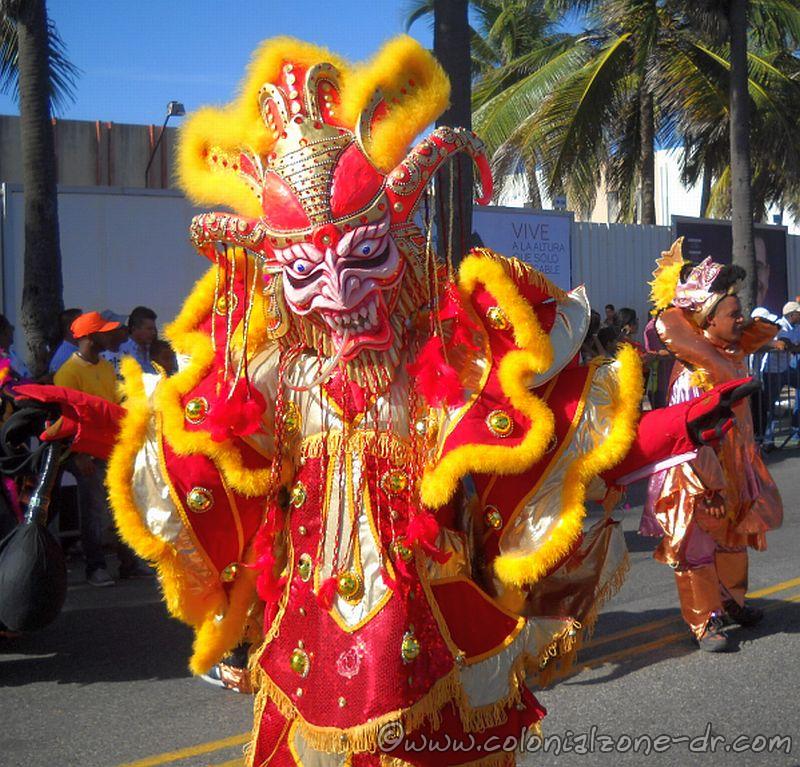
Some of the masks are homemade by the wearers and the group participants. The more elaborate costumes are professionally made using real teeth, horns and skins mainly of cows. Traditionally they make a mold of clay and cover it with a yucca starch paste like papier-mâché (paper mache). The masks are shined, painted and decorated. The inside is lined with foam fashioned to fit the wearers face. Recently the mask making process has changed a little. Many of the masks now are being made with plastic replacing the paper. When the mold is ready they are using fiberglass, rubber and silicone. This makes the making of the masks faster and these new-style masks are more resistant to sweat and weather.
Carnival – Early History | Video – Slaves Abused By Spanish Captors | Celebrations Worldwide | Video – Children Dancing | Carnival – Dominican Tradition | The Economy of Carnival | Video-The Dancing Girls, Fire Throwers | La Vega | Santo Domingo | The Vejiga | Celebration Locations | Roba la Gallina Video | Dominican Republic Carnival Characters and Their History | Complete list of our Videos of Carnival | Links to all the Picture Albums |
Carnival Characters / Personajes del carnaval
Listed are some of the names of the masks and troupes I have located. There is so much variety and character descriptions I hope I got the information correct. Different people I ask and different sources I have read all have a little different information. At least you will get the general idea of how diverse, original and creative all these costumes and their creators really are.
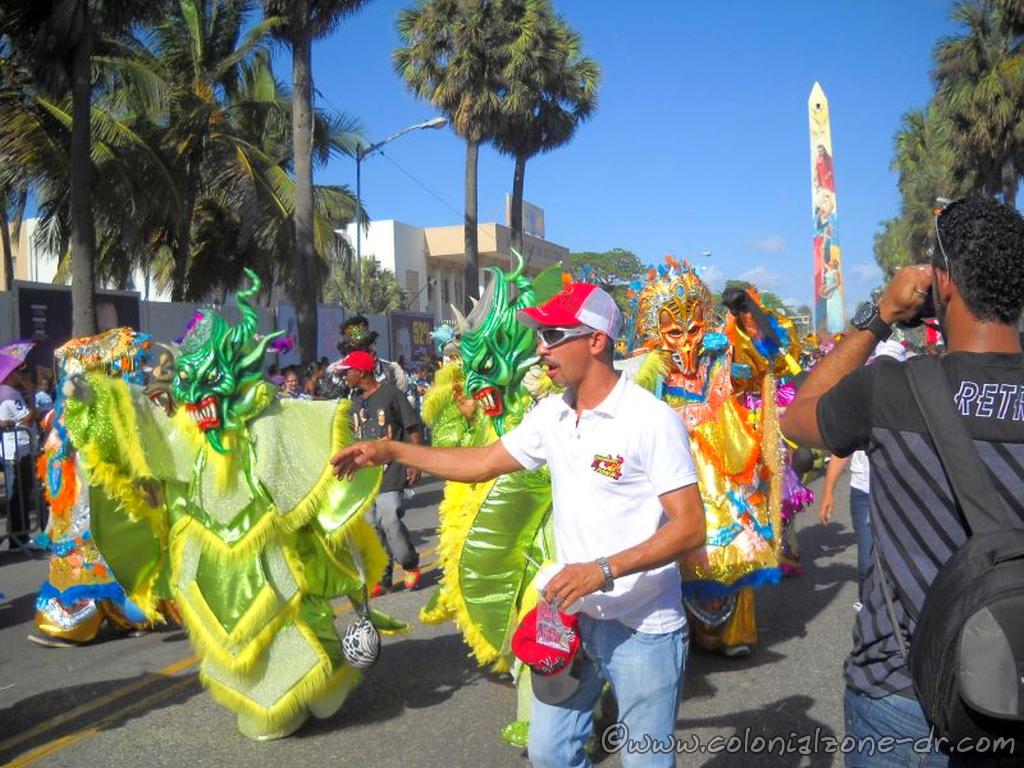
Diablo Cojuelos/ Devil who walks with a limp (from La Vega) masked demons are some of the most famous of all the carnival characters. This devil, as the story is told, was a demon banished to Earth because of his clownish pranks. When he fell to earth he hurt his leg and from now on always walks with a limp. These evil-looking creatures are multi-horned, sharp-toothed beings. They always have very elaborate masks.
Many of the regions have varying versions of this horrific devil. Some wear the mask atop their heads making it almost seem as if they have two faces. They all wear costumes that are brightly decorated with variations on the embellishments and mask styles. Some costumes are covered with bells, dolls or stuffed animals. These costumes can be layered with ruffles or all types of fancy vibrant decorations. Some have their complete heads and bodies covered where one cannot tell what human is inside. Their walk, supposedly limping, really looks to me like frenzied dancing and jumping. How they get all that energy wearing those hot costumes is beyond me.
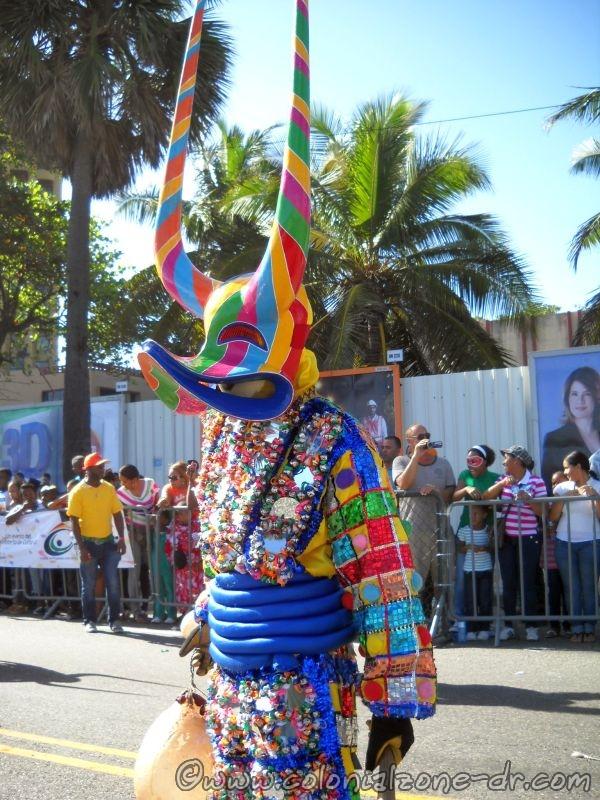
Lechones/ Pork Eaters (from Santiago) are traditional Carnival characters. They have elaborate galactic designed satin and taffeta costumes decorated with mirrors, beads and bells. They wear papier maché masks with a duck-like bill, big horns and carry a whip. Some of the masks resemble pigs.
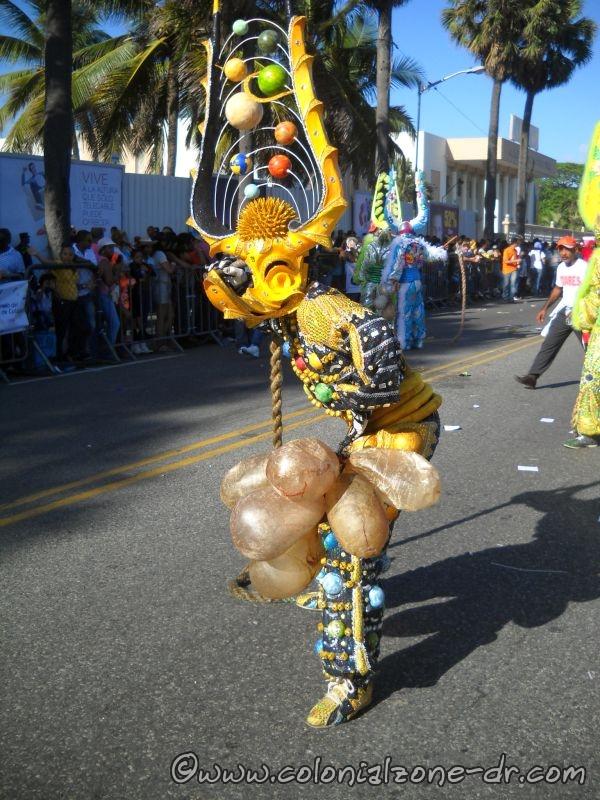
Watch the video of Los Lechones on YouTube
Nicolás Den Den (from Santiago) is a fat, dirty, dancing bear chained to his human master. His comedic antics make the children laugh. The same costumed characters in Montecristi is called el Oso Nicolás.

Los Platanuses (from Cibao) are covered in plantain leaves, wear painted gourd masks and carry the whip.
Trapuses/ Rag (from Bonao) wear long colorful rag strips that are woven together and have a mask of the same material or just paint their faces.
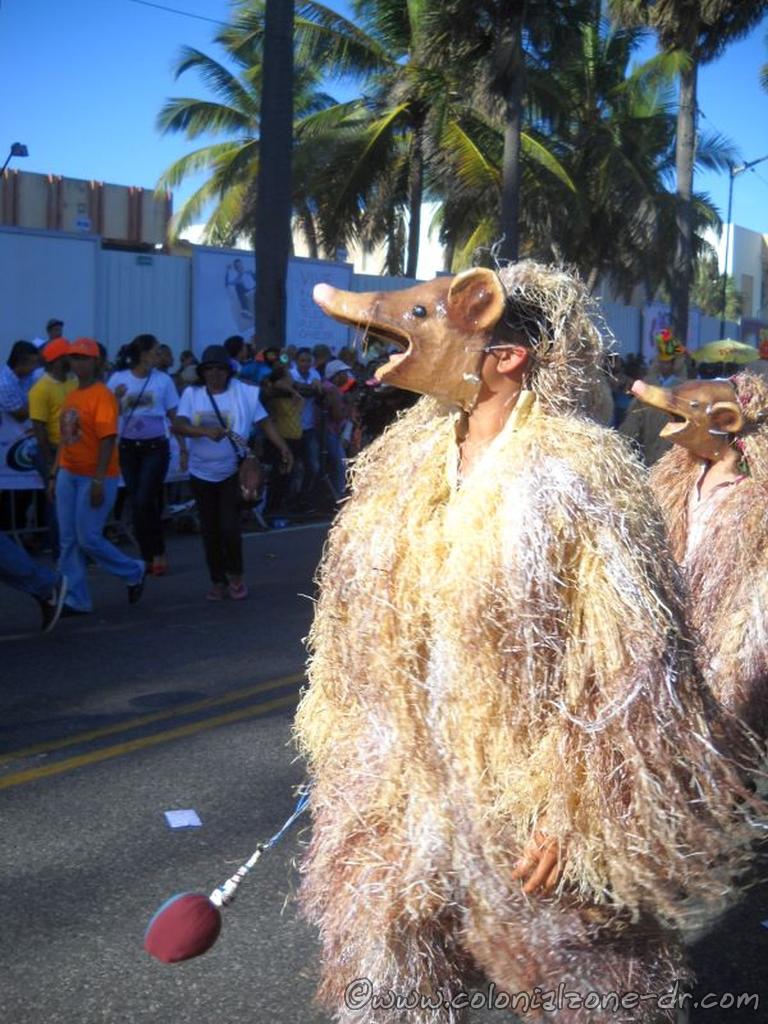
Papelus/ Paper Los Funduses /Bags (Cotuí, provincia Sánchez Ramírez) and El Papelón/ Newspaper print (from Salcedo) wear costumes made of shredded paper (newspapers, colored crepe paper, shopping bags) or colored plastic bags with gourd masks and carry vejigas/ the inflated bladder weapons or látigos/ whips
Se Me Muere Rebeca (Salcedo) – Represents a desperate mother who wants to keep her daughter who was seriously ill happy. Walking and screaming she stops and asks for treats for her ill daughter who is represented by the doll she carries. She is usually followed by groups of children.

Mudmen are a group of underwear wearing men and women that are encrusted with colored mud.
El Mediodía/ The MidDay is a man dressed as a woman with the colors of the flag painted on their face.
General Cocotico wears a palm leaf stem to represent armour.

Los Alí Babá These costumes and dance represent Eastern presence with an Arabian flair. Watch the Los Alibaba Drumming video on YouTube
Los Monos de Simonico/ The Monkeys (from Villa Duarte)
Máscaras del Diablo (from Elías Piña) – These devil masks are adorned with red ribbon. These mask wearers traditionally do not speak. It is said that if you find the identity of the person wearing the mask you will drop dead on the spot.
Macarao/ Big Mask (from Hermanas Mirabal/ Salcedo and Bonao) wear big devil masks that have large mean teeth representing different kinds of animals. Their clothing is made of crepe paper streamers.
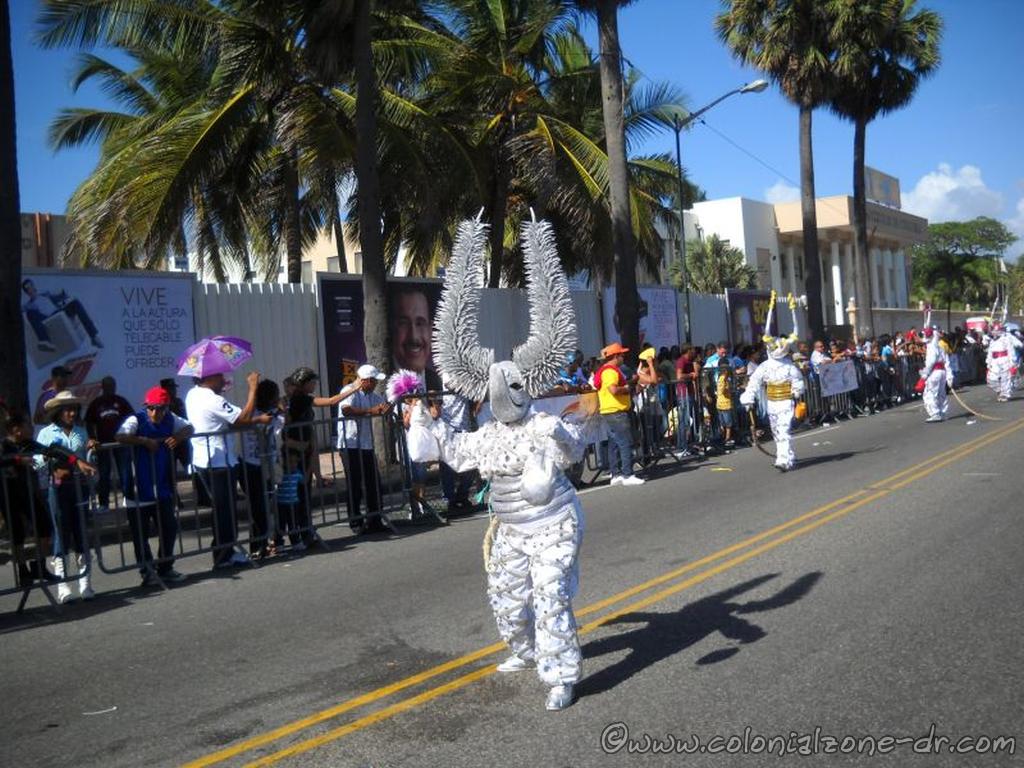
Pepines (from Santiago) wear masks with horns with short points covering them
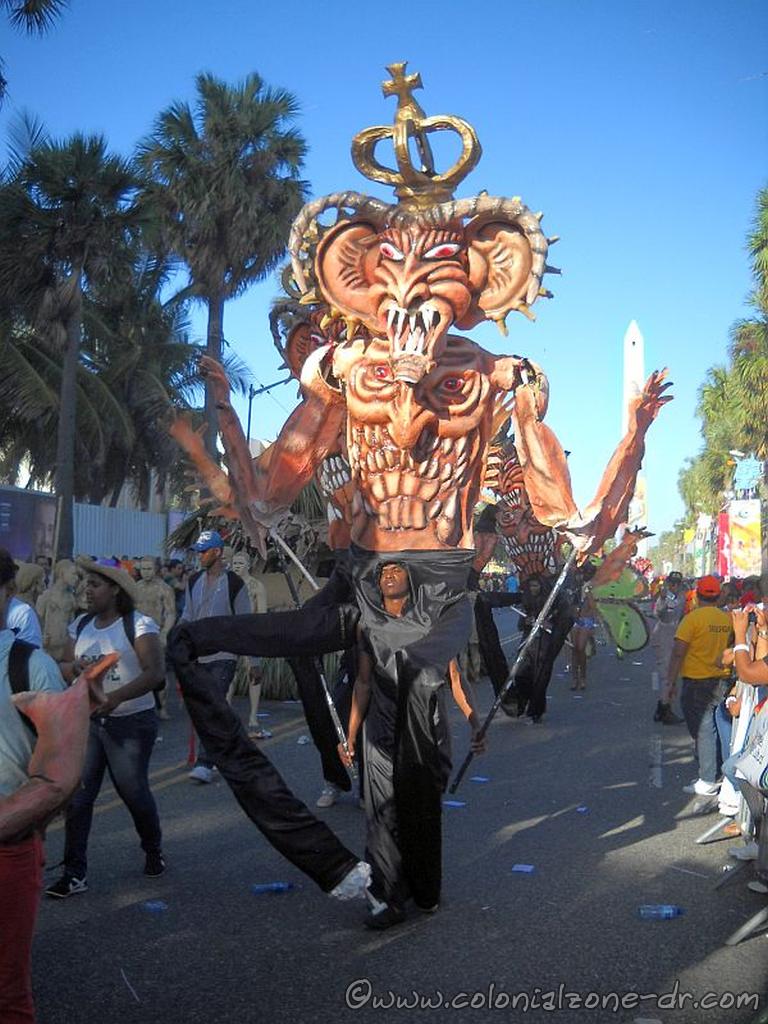
El Hombre en Zancos/ The Man on Stilts (from San Cristobal ) Have huge costumes either high above their heads or they are walking on stilts.
Taimácaros (from Puerto Plata ) are diablos wearing a mask that covers the entire body representing a Taino god or an ancient Spaniard, with a colorful shell covered belt at their waist.
Cachúa (from Barahona) has small spikes covering their devil mask many fashioned after the local creatures. The mask is covered with long, flowing, colored paper representing hair with their costumes having the bat looking wings, unique patterns and capes. These creatures jump around in the street and have whip-cracking battles. The louder the crack the better.
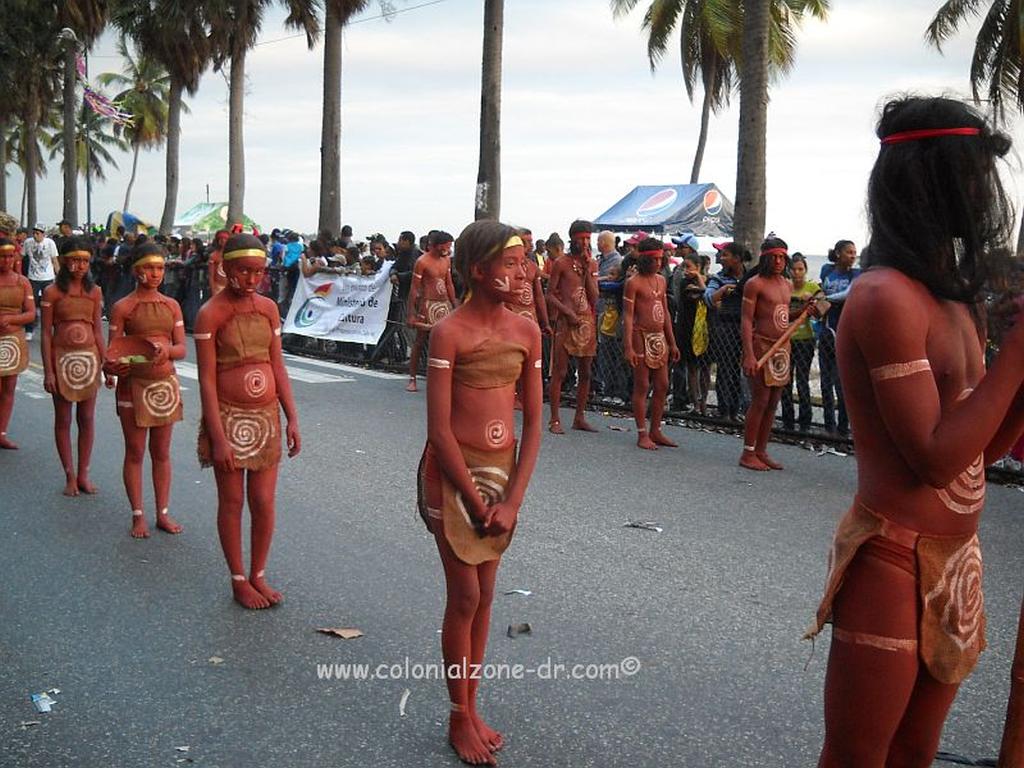
Los Indios/ The Indians (from Santiago) dress to look like he Taino Indians and act out different scenes.
Los Pirulíes (from Cabral Barahona) – These are children dressed as Indians with a skirt made of coconut leaves.
Muerte con su Perplegía/ Death in all its Perplexity.
Culebra y las Siete Pecados/ The Snake and the Seven Sins.
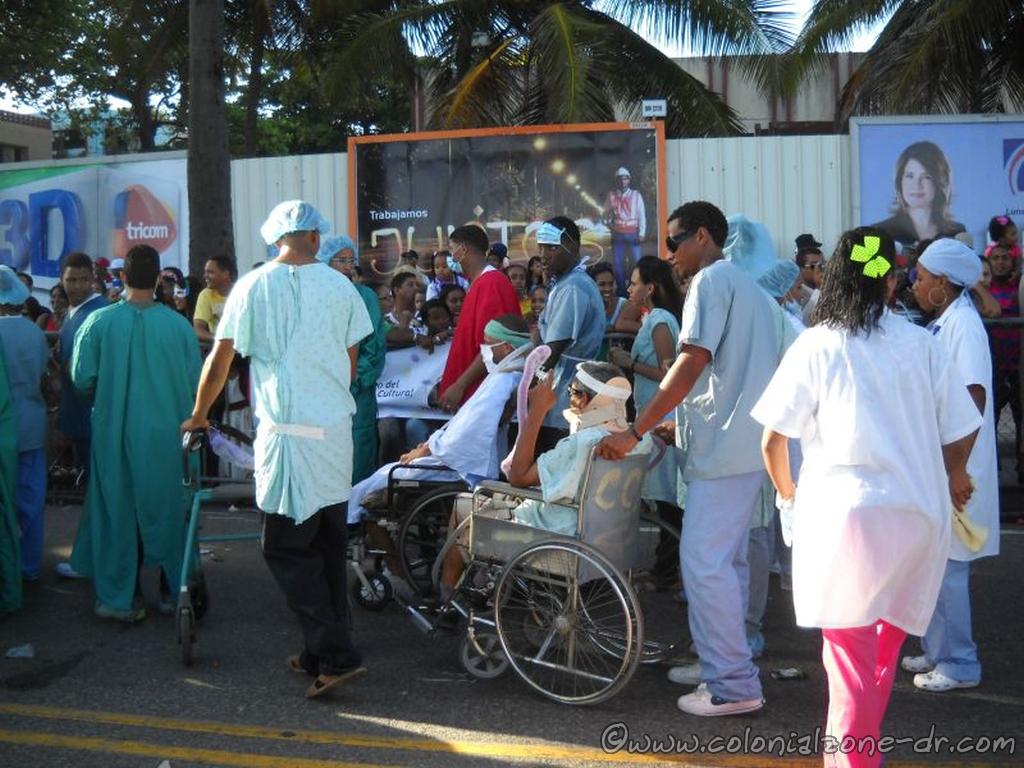
El Doctor/ The Doctor (from San Cristobal ) wears glasses made of wire and dried orange skins, running throughout the crowd looking for women to cure. There are also entire medical crews acting out different scenarios.
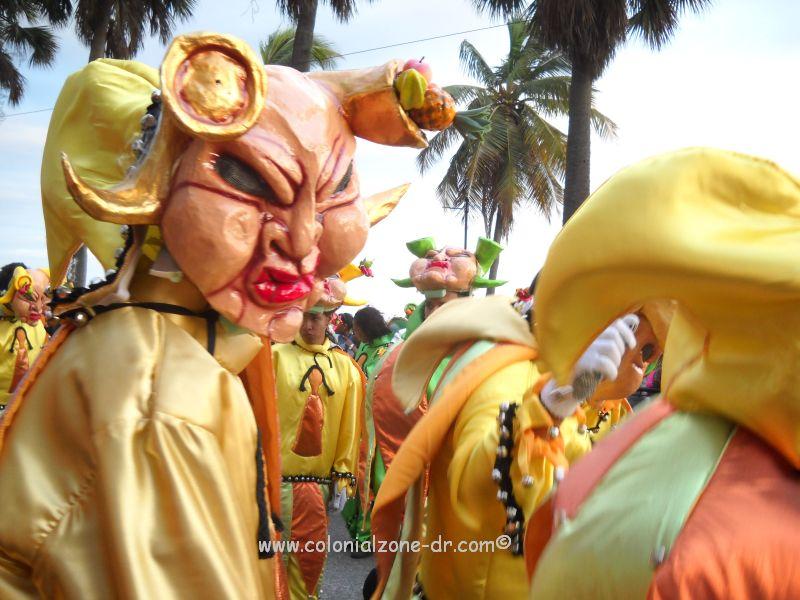
El Jinchaíto is the main person of carnival in Moca. They also have their other characters including Los Chacales, Los Búhos/ The Owls, Los Cibernéticos, Los Indeseables/ The Undesirable Ones, Los Coyotes/ The Cyotes, Los Diablos Azules/ The Blue Devils, Los Dragones/ The Dragons are among the most popular in this region. Read about the Legend of El Jinchaíto de Moca.

Los Brujos/ The Witches. Sometimes these characters can be quite frightening. The one pictured on the left blew fire out of his mouth.
Los Galleros This is a small play acted out in the streets between two farmers holding their roosters. They decide to fight their roosters in the middle of the street. While they are engaging in the fight the police arrive to stop the fight and arrest the men. This is one of the many play acting shows that occur during Carnival.
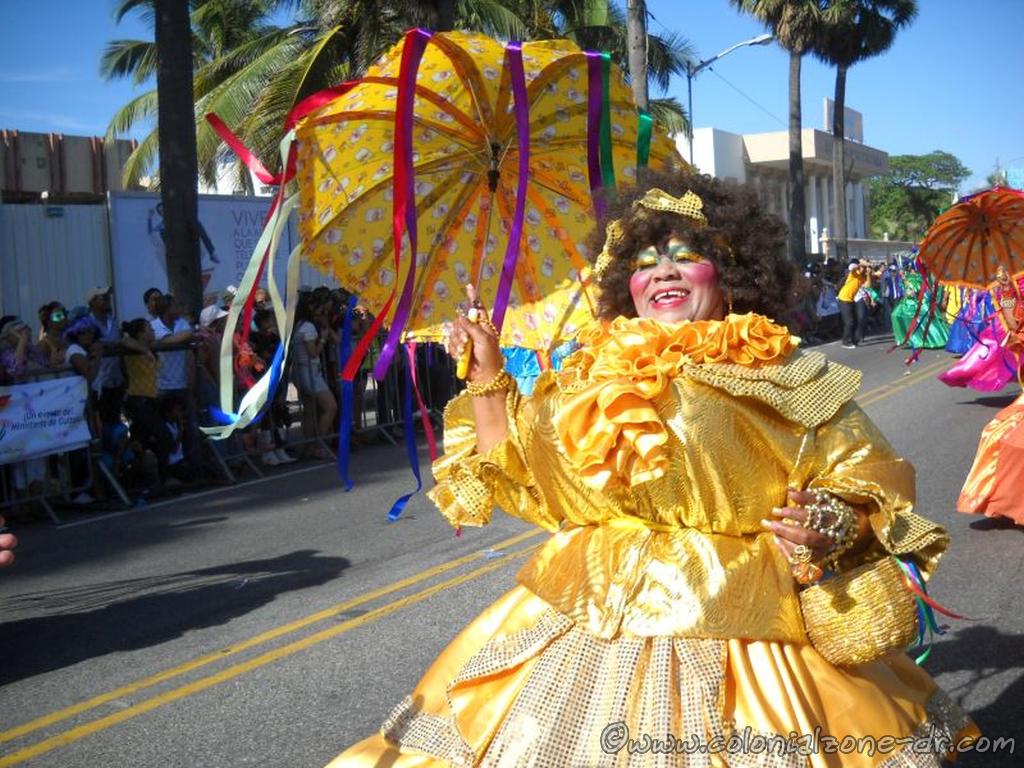
Roba la Gallina/ Chicken Robber (from San Cristobal and Salcedo) These fun characters are dressed in brightly colored dresses, with a huge butt and breasts, carrying an old umbrella and a big purse. This character hits all the Colmados begging for food and drink that he-she shares with the crowd representing its chicks. It is thought to come from the old tradition of tar and feathering a person that stole a chicken and making them walk through the streets. This bazaar person yells out silly rhymes (ti-ti, manatí, ton-ton, molondrón, roba la gallina, palo con ella) while he begs for food. This is a very popular Carnival character.
Guloyas (San Pedro de Macoris) dress in bright colors with long strips of cloth in red and yellow. The suit is decorated with mirrors. They dance around to the music of la flauta/ the flute, el cencerro/ bells la tambora/ drum.

Los Travestis/ The Transvestites are men dressing up as women that are to signify their machismo-ness. They are always a crowd favorite. (remember much of Carnival is opposites or the upside-down world).
Califé is a social and cultural poet. He makes verses that make jest and comically criticizes the government and political figures. He wears black and white with a big black hat.
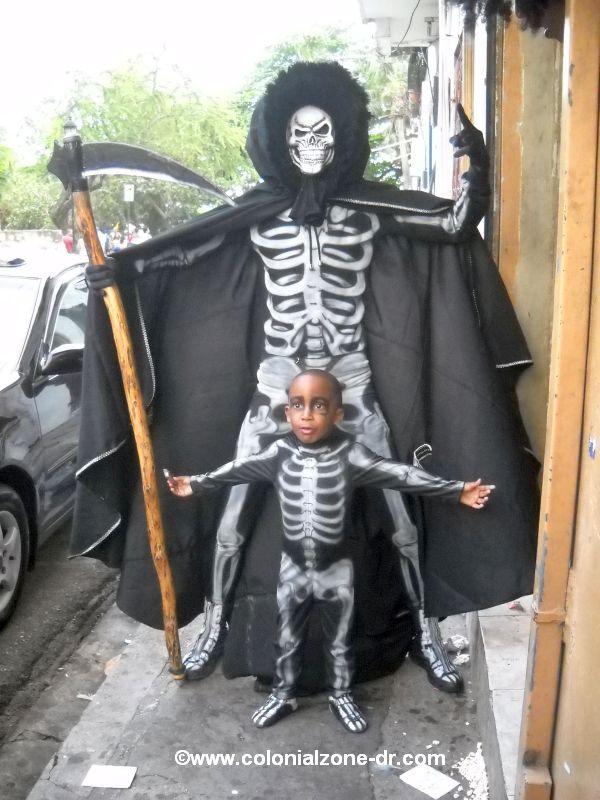
La Muerte en Yipe/ Death in a Jeep (Hermanas Mirabal/ Salcedo) is a skeleton and skull costumed death figure that has wounds dripping with blood. The name comes from the days when the Death characters used to climb up on the backs of the jeeps that towed the floats during the carnival parades. They hold a scythe.
The Civiles/ Civilians (from Montecristi) fight the Toros/ Bulls with loud cracking whips known as látigos. El Toro wears a dotted, flat animal mask and a thick padded costume to protect against the wrath of Los Civiles who crack their large whips that they use to fight the bull. These characters have mock battles that are not mock when the whip hits you! The bull will be the victor in the upside-down world of Carnival.
Las Marimantas (from Yerba Buena) – They cover their bodies in tree branches. Their heads are covered with a shell and the masks are made of cow leather.
Los Tiznaos/ The Stained Ones paint themselves with old motor oil that makes them a nasty shiny black. They run through the crowds accepting money so that they will not hug you.
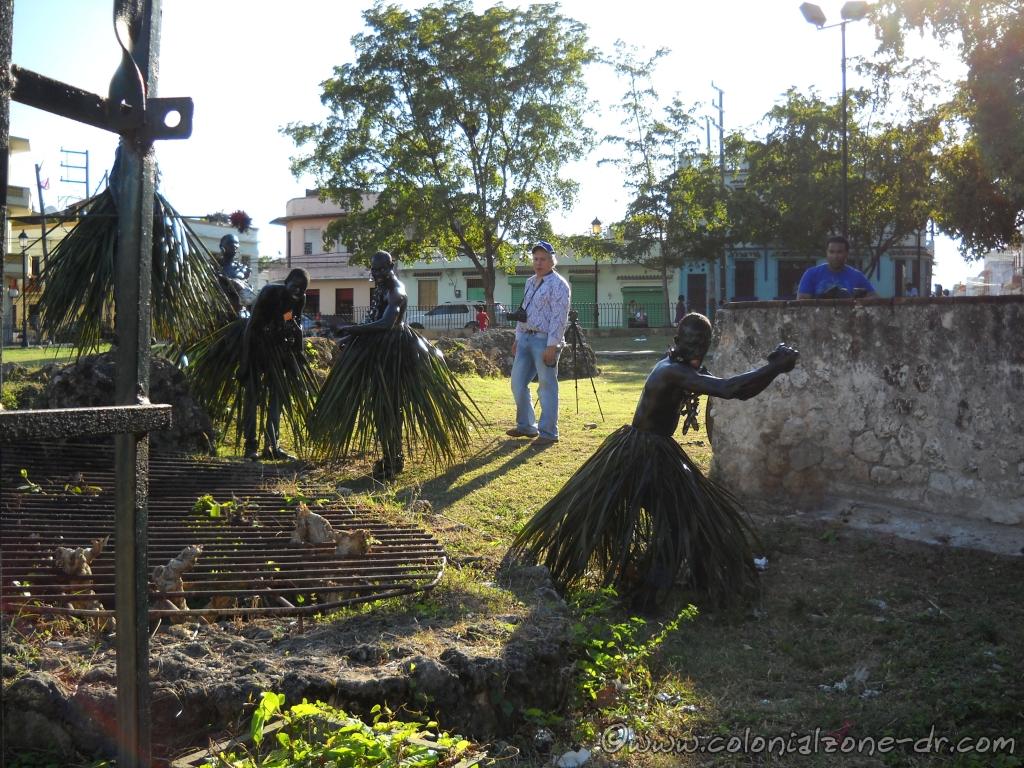
Africanos use charcoal to blacken their flesh and wear loincloths sometimes made from plantain leaves and do not wear shoes. They also carry a spear. Some wear afro wigs, paint their faces the color of the flag or wear gourd masks, all depending on what the character wants to do.
Complete list of our Videos of Carnival
Videos on YouTube I took in Santo Domingo, Dominican Republic on the Malecon and Elsewhere
Carnaval 2016 Video
*Carnaval Zona Colonial 2016
*Cueva de los Broncos con Claro Carnaval Vegano 2016
*Cueva de los Broncos con Claro Carnaval Vegano 2016 -Part 2
Carnaval 2013 Videos
*Carnaval Ciudad Colonial 2013
*Carnival Ciudad Colonial 2013 Starting
Carnival 2010 Videos
*Bailar en Calle-Slaves
*Dancing Girls and More.
Carnival 2011 Videos
*Cannot Stop Dancing at Carnival Dominicano 2011
*Music and Carnival Dominican Republic 2011
Carnival 2012 Videos
*Gaga Esperanza and Los Liones del Diablo
*Ucave Carnaval Vegano
*Haiti
*Sparkle Men
*The Group From Samana
*Los Brujos
*Lechones and Facebook
*Ali Baba and Other Groups
*Los Pintao Barahona
*Africanas on Stilts
*Roba la Gallina
*Los Indios and Fire Blower
*Dragon, Devil and Cavemen
*Gaga de Boca Chica
*Diablo Cojuelos
Carnaval 2008 Videos
*Los Alibaba Drumming
*Los Lechones dancing around

Links to all the Picture Albums
I put most of the pictures I took into slideshows. Some of the picture pages are very large files and some are in old formats. I hope you can enjoy the pictures.
*Carnaval in Ciudad Colonial 2013 Picture Album
*Dominican Republic Carnaval 2012 Picture SlideShow
*Pictures of Carnaval Dominicano / Dominican Carnival 2010
*Carnival 2008 slide show
*Old Carnival Pictures Slideshow
For more information about Carnival masks go to dominicanmasks.com
